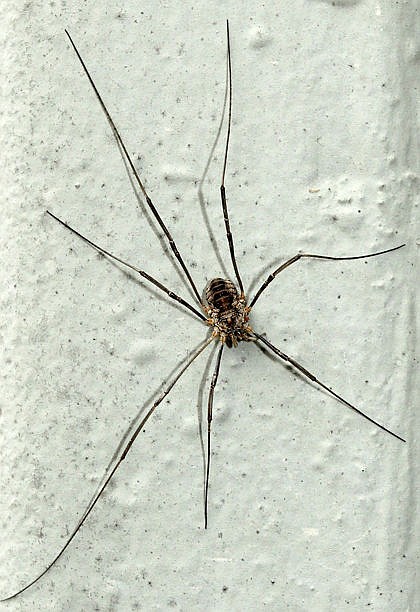Daddy longlegs not spiders or venomous
Laura Roady Outdoors Columnist | Hagadone News Network | UPDATED 11 years AGO
As a child I remember daddy longlegs in the basement bathroom, especially in the shower.
Not liking spiders, I never got close and took quick showers. I also believed the legend that daddy longlegs had enough venom to kill a person but their mouths weren’t big enough to bite us.
Not until later did I find out that daddy longlegs weren’t spiders and the legend is a myth.
Daddy longlegs (also called harvestmen, daddy-long-legs, opilionids, shepherd spiders, reapers and granddaddy-long-legs) are members of the class Arachnida which includes spiders, scorpions, mites and ticks.
However, daddy longlegs belong to the order Opiliones which is a different order than true spiders. While daddy longlegs can easily be confused with spiders because of the eight legs (which all arachnids possess), there are several distinct differences. One is the body.
The two body segments of true spiders are distinct while the body segments of a daddy longlegs appear fused together into a single large body segment. True spiders also have six or eight eyes whereas daddy longlegs only have two. The two eyes are on top of a small knob on their body and are pointed outward and to the sides.
Of course, I never looked at a daddy longlegs that closely as a child to recognize those differences. I also never paid attention that daddy longlegs weren’t sitting in spiderwebs but just clinging to the wall or ceiling. Daddy longlegs don’t have silk glands like spiders and therefore don’t spin webs or nests.
Another difference between spiders and daddy longlegs is that spiders have venomous fangs and harvestmen don’t have fangs or venom. This difference makes the above-mentioned legend a myth. The fang-like mouthparts (called chelicerae) and two antennae-like appendages near the mouth (called pedipalps) cannot inject venom because daddy longlegs don’t produce any venom.
Therefore, daddy longlegs pose no danger to humans. However, they are carnivorous and feed on invertebrate prey that includes aphids, beetles, caterpillars, earthworms, flies, mites, small slugs, snails and spiders. They also eat fecal matter and fungi.
The manner in which daddy longlegs eat is quite interesting. On the front pair of legs (which are the shortest), a three-jointed mouth organ forms the finger of a claw. A small pair of pincers underneath the claw is used to grasp, tear and stuff food into the mouth.
The legs of a daddy longlegs are impressive compared to the size of the body. The body averages five-sixteenth’s of an inch and the leg span can exceed six inches. If humans had comparable legs they would span up to 50 feet.
Their legs offer one form of protection from predators. A predator is more likely to grab a leg than the small body. Fortunately, the legs easily detach from the body and they continue to twitch for awhile (sometimes a minute or up to an hour) to allow the daddy longlegs to escape, just like the blue-tailed skink.
Of course, losing the first or second pair of legs would hinder the daddy longlegs since the first pair has a mouth organ and the second pair of legs is a sense organ comparable to a human eyes, nose and tongue.
If a daddy longlegs is disturbed, it will stand on six legs and wave its second pair of legs in the air to sense its surroundings.
Usually daddy longlegs aren’t seen frequently because they are nocturnal and prefer shady environments. But when they move from wooded areas into moist spots underneath eaves, in crawl spaces and in basements, we tend to notice them more even if they aren’t true spiders.
For previous columns visit http://goexploreit.blogspot.com.
ARTICLES BY LAURA ROADY OUTDOORS COLUMNIST

Spectacular views from the Shorty Peak Lookout
Waking up on top of a mountain as the horizon turns orange with nothing blocking the view is an amazing sight--especially from the comfort of a bed within four walls.

Not all bird eggs are created equal


